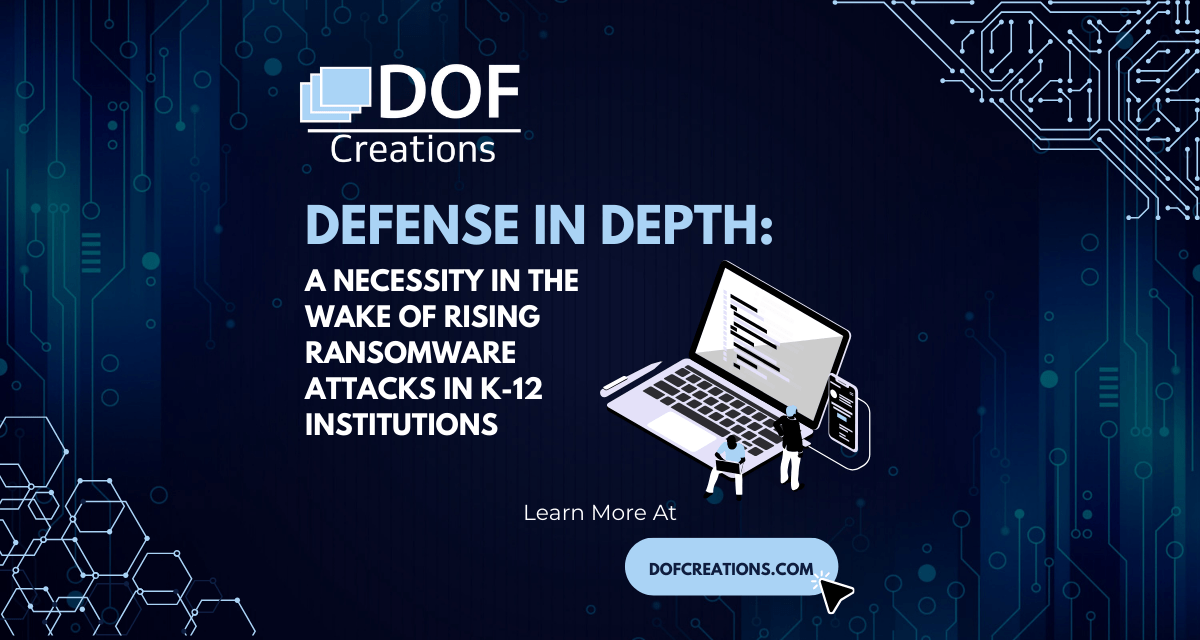Ransomware attacks, a persistent threat in the cyber landscape, have shown a surprising trend recently. While there has been a slight decline in overall ransomware attacks from 2021 to 2022, the frequency of these attacks targeting K-12 educational institutions has risen alarmingly. This trend suggests that the success of attacks in the K-12 sector is emboldening cybercriminals to increasingly target schools across the United States. In this context, the concept of Defense in Depth becomes crucial for educational institutions to protect themselves against these escalating threats.
The Rising Threat of Ransomware in K-12 Institutions
Ransomware attacks involve malicious software that encrypts an organization’s data, rendering it inaccessible until a ransom is paid. For K-12 institutions, the impact is profound: compromised personal data of students and staff, disrupted learning environments, and significant financial losses.
Why K-12 Institutions Are Vulnerable:
- Limited Resources: Many schools lack the necessary resources and funding for advanced cybersecurity measures.
- High-Value Data: Schools hold sensitive data, including student records and staff information, making them lucrative targets.
- Lack of Awareness: There is often a gap in cybersecurity awareness among staff and students in educational settings.
The Concept of Defense in Depth
Defense in Depth is a layered approach to cybersecurity, which involves implementing multiple defensive mechanisms at various levels within an IT system. This strategy assumes that if one layer fails, the subsequent layers will continue to provide protection.
Key Components of Defense in Depth:
- Perimeter Security: This includes firewalls, intrusion detection systems, and border routers to protect against external threats.
- Network Security: Implementing network segmentation, secure Wi-Fi protocols, and intrusion prevention systems.
- Endpoint Security: Ensuring up-to-date antivirus software, anti-malware programs, and patch management for all devices.
- Application Security: Securing all software applications, especially those used for remote learning and administration.
- Data Security: Encrypting sensitive data and implementing strict access control policies.
- User Training and Awareness: Educating staff and students about cybersecurity best practices and potential threats.
Implementing Defense in Depth in K-12 Institutions
- Assessment and Planning: Conduct a thorough security assessment to identify vulnerabilities and plan a comprehensive defense strategy.
- Layered Security Measures: Deploy multiple security layers, from perimeter defenses to data encryption and access controls.
- Continuous Monitoring and Response: Implement security monitoring tools to detect and respond to threats in real-time.
- Regular Updates and Maintenance: Keep all systems and security measures up to date with the latest patches and updates.
- Cybersecurity Education: Regularly conduct cybersecurity awareness programs for students and staff.
- Incident Response Planning: Develop and maintain an incident response plan to quickly and effectively address any security breaches.
Challenges and Considerations
- Budget Constraints: Balancing the need for comprehensive security measures with often limited budgetary resources in K-12 institutions.
- Balancing Accessibility and Security: Ensuring that security measures do not hinder the educational process or accessibility for students and staff.
- Adapting to Evolving Threats: Keeping up with the rapidly evolving nature of cyber threats.
The increasing frequency of ransomware attacks on K-12 institutions underscores the urgent need for comprehensive cybersecurity strategies. Implementing a Defense in Depth approach offers a multi-layered safeguard against these threats, ensuring the continuity and integrity of educational services. As cybercriminals continue to target vulnerable sectors, the importance of robust, adaptable, and multi-faceted defense mechanisms cannot be overstated. By investing in and prioritizing cybersecurity, educational institutions can create a safer digital environment for learning and growth.



